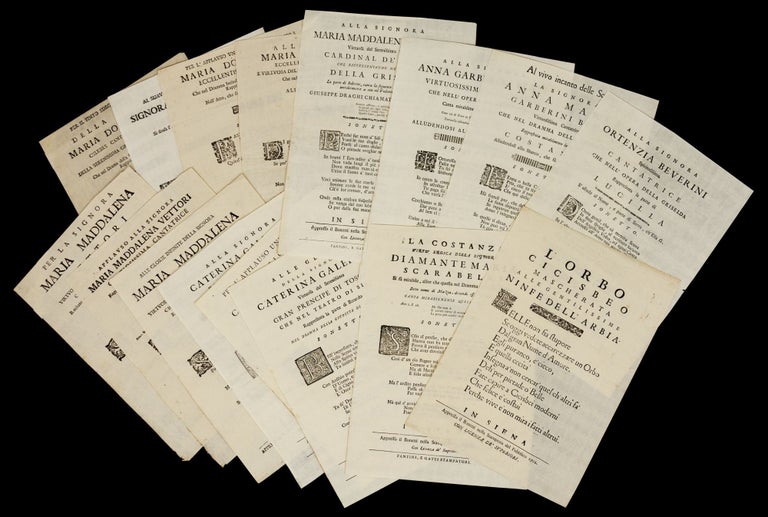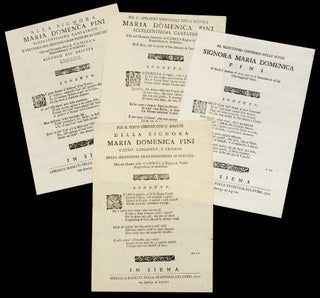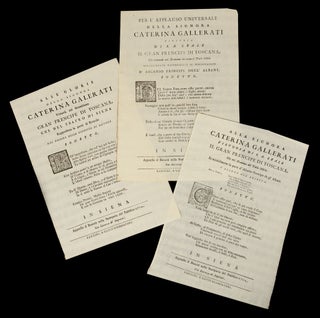1. Al suavissimo usignolo delle scene signora Maria Domenica Pini si scusa l’Autore d’aver così tardi decantata la di lei impareggiabil Virtù. In Siena, Bonetti, 1700. 2. Per il finto sdegno con l’amante della signora Maria Domenica Pini celebre cantatrice, e virtuosa della serenissima Gran Prencipessa di Toscana. Che nel Drama della Camilla Regina de Volsci Rappresenta la medesima. In Siena, Bonetti, 1700. 3. Per l’applauso universale della signora Maria Domenica Pini eccellentissima cantatrice Che nel Dramma Intitolato la Camilla Regina de’ Volscij, Rappresenta la medesima. In Siena, Bonetti, 1700. 4. Alla signora Maria Domenica Pini eccellentissima cantatrice e virtuosa del sereniss. Gran Principe di Toscana, Che nel Dramma detto la Camilla. Rappresentante la medesima. In Siena, Bonetti, 1700. 5. Per la signora Maria Maddalena Vettori virtuosa del sereniss. Gran Principe di Toscana che nel dramma della Camilla Recitato in Siena Rappresenta maravigliosamente la parte di Lavinia… In Siena, Bonetti, 1700. 6. Applauso alla signora Maria Maddalena Vettori gratiosissima cantatrice Rappresentante la Persona di Lavinia nel Dramma Intitolato la Camilla. In Siena, Bonetti, 1700. 7. Alle glorie infinite della signora Maria Maddalena Vittori virtuosa del sereniss. Gran Principe di Toscana che nel dramma della Camilla Rappresentando egregiamente la parte di Lavinia, prende gelosia di Turno. In Siena, Bonetti, 1700. 8. Alla signora Caterina Gallerati virtuosa di S. A. Reale il Gran Prencipe di Toscana, Che nel Dramma del Tullo Ostilio fa mirabilmente la parte d’ Ascanio Prencipe de gl’ Albani. In Siena, Bonetti, 1702. 9. Per l’applauso universale della signora Caterina Gallerati virtuosa di S. A. Reale il Gran Prencipe di Toscana, Che recitando nel Dramma intitolato il Tullio Ostilio mirabilmente Rappresenta il personaggio d’ Ascanio Principe degl’ Albani. In Siena, Bonetti, 1702. 10. Alle glorie della signora Caterina Galerati Virtuosa del Serenissimo Gran Prencipe di Toscana, che nel teatro di Siena Rappresenta la parte di Berardo nel dramma della Giuditta di Baviera. In Siena, Bonetti, 1702. 11. Alla signora Anna Garberini Benti virtuosissima cantatrice che nell’ opera de’ Decemviri Canta mirabilmente le due Ariette Come và di Fiore in Fiore &c. … Tortorella abba sonata &c. … In Siena, Bonetti, 1703. 12. Al vivo incanto delle Scene la signora Anna Maria Garberini Benti Virtuosissima Cantatrice che nel dramma della Griselda Rappresenta mirabilmente la parte di Costanza. In Siena, Bonetti, 1704. 13. La costanza virtu’ eroica della signora Diamante Maria Scarabelli Si fà mirabile, allor che questa nel Dramma del Tullo Ostilio Soto nome di Marzia, dovendo esser saettata… In Siena, Bonetti, 1702. 14. L’orbo Cicisbeo mascherata alle gentilissime ninfe dell’ Arbia. In Siena, Bonetti, 1702. 15. Alla signora Ortenzia Beverini Spritosissima cantatrice che nell’ opera della Griselda Rappresenta la parte di Lucilla… In Siena, Bonetti, 1704. 16. Alla signora Maria Maddalena Fratini Virtuosa del Serenissimo Signore Cardinal de’ Medici che rappresentando nel dramma della Griselda La parte di Roberto… In Siena, Bonetti, 1704. Sixteen broadsides with laudatory sonnets addressed to female singers, who featured in several opera productions in Siena (Italy) from 1700 to 1704. These materials are not only an invaluable source for the history of Italian opera, but also offer an understanding of the position of women in Italian opera and society in the Early Modern period. Siena, just forty-four miles south of Florence, was a peripheral opera center. Despite its proximity and political ties with Florence, where opera flourished all throughout the seventeenth century, Siena did not see its first operatic production until 1669. At the time of the publication of these broadsides, it was already part of an international opera circuit. The broadsides include the names of the singers, the titles of operas, and the singers' parts in them. In several cases, patrons of the singers are mentioned: the Grand Duke and Duchess of Tuscany, and a Medici Cardinal. Sixteen of the broadsides were published in the printing shop at the venue of the theatrical productions in Siena, the Palazzo Pubblico. Such broadsides were commonly distributed during and/or after the run of an opera to create publicity for the production and satisfy the admirers of singers. The standing of women in early eighteenth-century opera was rather precarious. To quote Rosselli, "exposure to men was the trouble -- not just to men in the audience but to fellow-workers in the theatre. In Italy as in other Mediterranean countries, respectable women were meant to be seen, if at all, at home or in a few public places, especially in church, accompanied by relatives or duennas... Women singers in the early days of opera, then, existed as objects of male expectancy, at once dubious and entrancing." [Rosselli, Singers of Italian Opera, pp. 56-59]. The first through seventh broadsides sing praises to the only two female singers in Camilla, regina de’ Volsci – Maria Maddalena Vettori (La Marsoppina) and Maria Domenica Pini (la Tilla) (1670/71-1746). The latter was a Florentine soprano, who was "so much admired by her patron, Prince Ferdinando de' Medici, that he would later ask the composers Alessandro Scarlatti and Giacomo Petri to rewrite roles so as to make them more suitable for her" [Reardon, A Sociable Moment, p. 212]. The production also marked the début of the singer who would later become known as the "Great Sienese," Francesco Bernardi [Reardon, A Sociable Moment, p. 208]. This Camilla was very likely the work initially titled Il Trionfo di Camilla, Regina de’ Volsci, a dramma per musica by Giovanni Bononcini with libretto by Silvio Stampiglia which premiered in Naples in 1696. The opera was an unrivalled success, inspiring 38 known productions by 1767, including versions entitled La rinovata Camilla and La fede in cimento [Lindgren]. The eighth, ninth and tenth sonnets are for Caterina Gallerati who often portrayed the travesti roles - a specialty which would serve her for the rest of her career. Il Tullo Ostilio was first staged in Pisa and Florence in 1701 under the patronage of the Medici court. The main female parts in the Sienese production were given to Diamante Maria Scarabelli (fl. 1692-1718), at the time a rising star, and Caterina Galerati (fl. 1701-21)—who was only at the beginning of their career. The thirteenth was written for Diamante Maria Scarabelli (fl. 1692-1718), who in 1702 had the patronage of the Duke of Mantua [Grove]. She would later originate the role of Poppea in Händel’s Agrippina, in 1709. Lindgren, L. Trionfo di Camilla, regina de’ Volsci, Il. Grove Music Online. Retrieved 24 Feb. 2023, from https://www-oxfordmusiconline-com.ccny proxy1.libr.ccny.cuny.edu/grovemusic/view/10.1093/gmo/9781561592630.001.0001/omo-9781561592630-e-5000002344.
Each broadside measures 260 x 370 cm, with recto printed and verso blank. Ornamented initials in the first word of each sonnet. Excellent.
Price: $4,950.00



